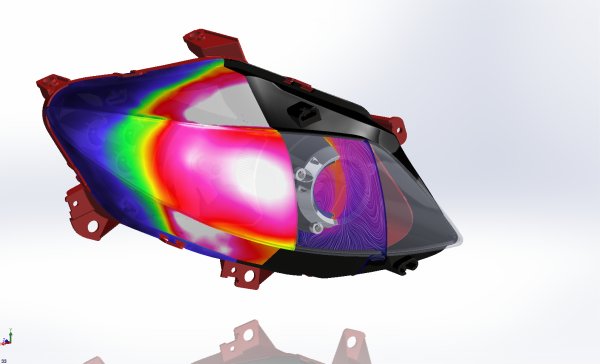The exterior conceals new technology behind the bezels that make possible such features as adaptive beams and LED matrix beams, for example. Often, each LED has its own lens that is held by a fixture, and light guides with small saw-tooth structures to direct the light to the road and to the external viewer are used more often.
All of these new structural changes and components have caused the overall complexity of the headlights to explode.
And the choices offered in new models increase the variety of systems even more, adding to the complexity. For example, the new Audi TT comes with three choices of headlight systems (full LED, matrix LED, and Xenon). Ensuring the performance and reliability of the lighting system is not getting any easier with so much more complexity and variety.
The only constant in design to date is the thermal management aspect of the design. This task has to be handled with computational fluid dynamics (CFD) simulation software because creating prototypes for each change and different systems is inefficient and costly.
CFD simulations are traditionally done by analysts with specialised skills in advanced math and fluid dynamics, plus a command of the complex modeling tools required for CFD work. The CFD analyst has to assign grids to the solids and flow spaces, creating an optimised computing mesh. This mesh aids the engineer in setting boundary conditions and influences the solution convergence as well as accuracy of the result.
Mesh generation for a new lighting system can be very time consuming, and often even before the mesh in generated, a CAD model needs to be prepared to simplify the geometry for the mesh generation.
When you take a close look at the actual geometry of a headlight, there are a lot of fine details such as the saw-tooth structure of the light guides or small ribs on the reflector, or bezels for the stray light creation onto the road signs above the road, or the small facetted surfaces of the orange plastic of the turning indicator.
Such small structures are a pain in every traditional meshing process. But the worst part of it is when the mesh is finally completed after several days of manual work, the design is changed slightly before the first simulation is even run.
With the automotive lighting industry so strongly linked to the design, a better solution is required that is much more upfront in the design process and automates laborious tasks such as meshing and eliminates the geometry simplification.
Such a frontloading approach to create a highly accurate mesh automatically and directly on the native CAD geometry is incorporated in today’s CFD tools such as FloEFD, which is integrated with MCAD tools such as CATIA V5, ProE/Creo, and Siemens NX.
This approach enables design engineers to be up-to-date with the simulation on the latest design, and automatic meshing can dramatically reduce the manual workload.
Imagine you are a Tier 1 automotive supplier in the beginning stages of a new competitive offering to an OEM. The benefit of an upfront thermal simulation is that with a very rough design model you can already evaluate temperatures in that design.
Initial material selection can then go into the basic pricing calculations. Any change at that stage in the CAD model is directly up-to-date in the simulation project as well. This is basically the very first start where the software can be used, as soon as there is some CAD geometry available. It can later be extended to the fully modeled lighting system with all its features. For each design change, the simulation project is directly up-to-date.
Thermal simulation is critical to avoid any damages of the system or light source caused by either environmental impacts, such as solar radiation, or a badly designed system.
A fan, for the cooling of the HB-LEDs, could create a thermal short circuit—that is when the hotter air that comes out of the heatsink from the HB-LEDs is sucked back into the fan and reused, drastically reducing the cooling efficiency. This results in an even hotter LED junction temperature and a damaged model. In the physical assembly, this is costly and time consuming, and unnecessary when the error can be easily caught within the simulation.
For more detail: LED car headlight design can benefit from thermal simulation, says Mentor


